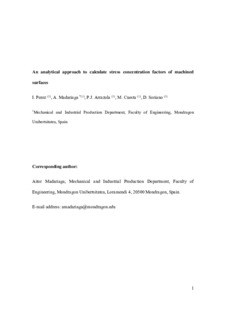
Izenburua
An analytical approach to calculate stress concentration factors of machined surfacesEgilea
Argitalpen data
2021Bertsioa
PostprintaDokumentu-mota
ArtikuluaArtikuluaHizkuntza
IngelesaEskubideak
© 2020 Elsevier Ltd.Sarbidea
Sarbide bahituaBahituraren amaiera data
2023-01-31Argitaratzailearen bertsioa
https://doi.org/10.1016/j.ijmecsci.2020.106040Non argitaratua
International Journal of Mechanical Sciences Vol. 190. N. artículo 106040, 2021Argitaratzailea
Elsevier Ltd.Gako-hitzak
Surface topographyStress concentration factor
Fatigue
Modelling
Laburpena
Machining operations affect the properties of the final surface layer, and these can impact on its functional per- formance, particularly on fatigue behaviour. Among the properties of the machined sur ... [+]
Machining operations affect the properties of the final surface layer, and these can impact on its functional per- formance, particularly on fatigue behaviour. Among the properties of the machined surface, surface topography is one major parameter affecting fatigue behaviour. The literature review has demonstrated that stress concen- tration factors K t of the surface provide a more reliable estimation of the impact on the fatigue behaviour of machined components. Finite Element (FE) simulations can accurately calculate the stress concentration factor of machined surfaces, but they incur a high computational cost. Recent advances have shown that analytical models can reliably determine stress concentration factors of 2D roughness profiles. However, analytical models that predict stress concentration factors of 3D surface topographies are still lacking. This paper is aimed at devel- oping an analytical method to calculate the stress concentration factor K t of 3D surfaces generated by machining operations. To validate the model, a specimen of 7475-T7351 aluminium alloy was face milled and its surface topography was characterised using an Alicona IFG4 profilometer. Stress concentration factors were calculated in the selected surface regions using the proposed analytical model, and later compared to results obtained by FE simulations. The mean difference in the stress concentration factor K t calculated by the proposed analytical and FE models is of 1.53%. Importantly, the developed analytical model reduces the computing time by 3000 times compared to FE models, and enables the analysis of larger surfaces. [-]




















